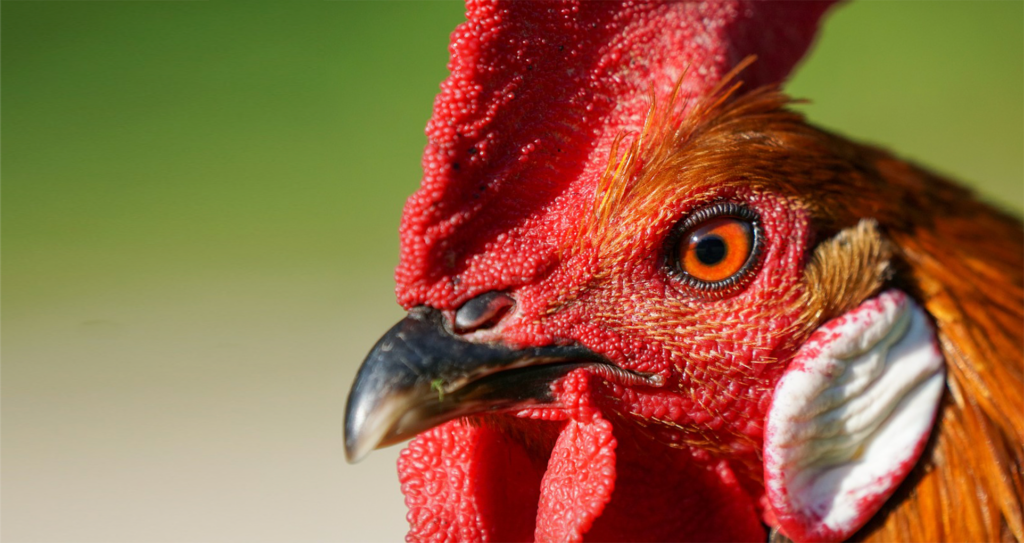Today’s guest post was contributed by Miriam Bergeret, MSc, a scientific writer and editor. Her work can be found at pensandpipettes.com.
While the controversial practice of cock fighting was recently criminalized across the United States, it remains part of many cultures throughout the world. At first glance, fighting chickens look like ordinary chickens raised for livestock, but these so-called gamecocks have been selectively bred over thousands of years to be highly aggressive. Now, research published in the February issue of G3: Genes|Genomes|Genetics pinpoints the genetic origins of that aggression.
Evidence suggests that cockfights took place as early as 2700 BC in China and 2500 BC in the Indus Valley, which was then home to the Bronze Age Harappan civilization. Gamecocks continue to be bred for cock fighting worldwide with well over a hundred breeds sharing high levels of aggression. In contrast, ordinary “nongame” chickens, which were domesticated from wild red junglefowl, are far less likely to initiate or engage in a fight. Though scientists have identified genetic regions distinct to local populations of Chinese gamecocks, the larger genetic relationship between gamecocks and nongame chickens, as well as the genetic basis of gamecock traits, has not been definitively established.
To address these questions, Bendesky et al. sequenced the genomes of gamecocks from around the world alongside a representative set of nongame chickens. They combined their data with other published chicken genomes to form a large, diverse dataset that includes samples from 12 countries and 108 recognized chicken breeds.
Through a genome-wide association analysis, the authors found that gamecocks have a specific “game ancestry” related to a non-coding variant within the isoprenoid synthase domain containing gene (ISPD), which has been implicated in muscular dystrophy-dystroglycanopathy in humans. Present at a frequency of 89.5 percent in gamecocks compared to 3.7 percent in nongame chickens, the variant is what most strongly differentiates gamecocks and nongame chickens worldwide. Likely the result of selective breeding for aggression in gamecocks and against aggression in nongame chickens, the near absence of this variant in nongame chickens suggests it may be the key to gamecock aggression—finally giving us an explanation for why gamecocks are always in a “fowl” mood.
The researchers also report that genetic similarities among chickens are largely based on geographic proximity, with gamecocks clustering with other chickens of similar regions. What’s more, the evolutionary patterns reflect historical colonization events, with North and South American gamecocks most closely related to chickens from Spain.
Though gamecocks did not cluster together, when examining the ISPD locus, the authors found it to be highly differentiated and very similar among most gamecocks but not nongame chickens. Based on this ancestral pecking order, it’s likely that gamecocks originated from a common ancestor before intermixing with local chicken populations throughout the world, where selective breeding for cock fighting maintained their aggressive traits.
Although genetic variation at the ISPD locus could affect several genes, the authors posit that ISPD itself may be the target of that variation due to its proximity and known involvement in axon guidance during brain development. This offers a potential explanation of how variation around ISPD may contribute to behavioral changes associated with aggression in gamecocks beyond its effects on muscle. Many of the breeds included in the study had not previously been sequenced at this depth of coverage. By assembling the largest and most diverse chicken genome dataset to date, the authors hope to provide a much-needed genomic resource for agricultural genetics. Because variants associated with gamecocks can still be selected against in nongame chickens, it may be within our reach to selectively reduce aggression in nongame chickens to avoid ruffling any feathers.
References
The main genetic locus associated with the evolution of gamecocks is centered on ISPD
Andres Bendesky, Joseph Brew, Kerel X Francis, Enrique F Tello Corbetto, Antonio González Ariza, Sergio Nogales Baena, Tsuyoshi Shimmura
G3: Genes|Genomes|Genetics. February 2024; 14(2).
DOI: 10.1093/g3journal/jkad267




